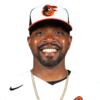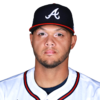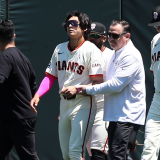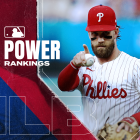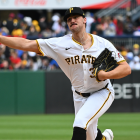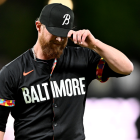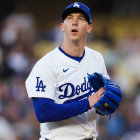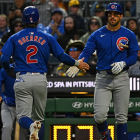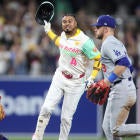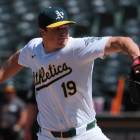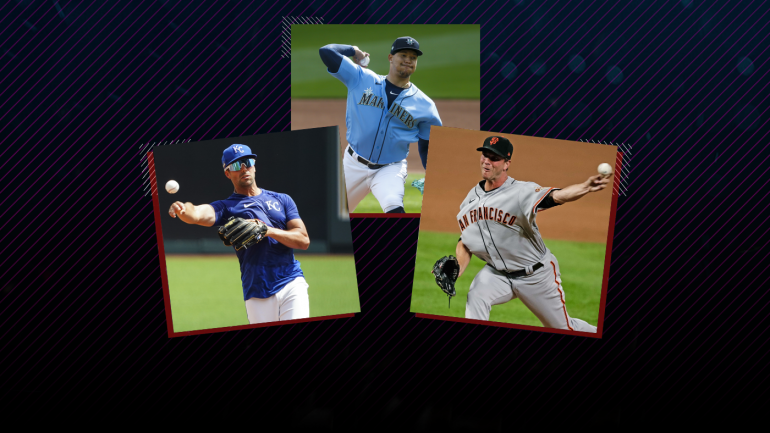
Although Major League Baseball's regular season is not yet a month old, the trade deadline is just two weeks away. Teams will have until Aug. 31, and only until Aug. 31, to decide whether they should add, subtract, or stand pat ahead of September and the stretch run.
Predictably, this year's trade deadline is unlikely to be business as usual. The standings are congested with teams hoping to reach the expanded postseason. Those same teams are said by league sources to be wary of adding money, given the pandemic and the financial ramifications that will stem from a shortened season played without fans. In other words, the environment isn't right for a team to step up and trade for Francisco Lindor or Nolan Arenado.
Be that as it may be, there will still be trades made in advance of the deadline. Below, we've highlighted 25 players who could, conceivably, be on the move before the whistle blows. Do note that the players are ordered alphabetically within their respective groupings, and that, yes, we do appreciate the absurdity of this exercise.
Four starters to target
Kevin Gausman has made subtle adjustments to his delivery that have him throwing harder (95 mph on average) than he has in some time, even including his stint last season in the Reds bullpen. He's finding the zone more frequently as well, having thrown 70 percent strikes and having amassed a 23-to-2 strikeout-to-walk ratio through his first four appearances. Gausman's formula is simple: he stair-steps with high fastballs and low splitters while mixing in the occasional slider, a pitch he had previously put on the shelf. Because Gausman is a free agent at season's end, the Giants have no long-term incentive for keeping him around.
If Gausman and Drew Smyly's starts to the season are any indication, the Giants are going to develop a reputation for restoring veteran pitchers. Smyly too has improved his velocity, allowing him to average north of 93 mph on his fastball for the first time in his career. He's also upped the spin rate on each of his three pitches, and has taken to using his breaking ball as his primary offering. It's too early to know if Smyly's career-best whiff rate is sustainable, but if a team trades for him, they should follow the Giants' lead by limiting his exposure: Smyly has faced just 32 batters in two starts to date, or, on average, less than two trips through the order.
Because Taijuan Walker required Tommy John surgery in 2018, he's already made as many starts this season (four) as he had in the past two years combined. He used the rehab and recovery period to overhaul his mechanics. The start of his delivery now resembles David Price's, and that's arguably not the most jarring change he made. That distinction should go instead to his shortened arm action or to his reworked landing that no longer sees him throw across his body. Walker has tweaked his pitch selection, too, with him relying more on his cutter and splitter. His seasonal numbers are in line with what he's done throughout his career, so all the tinkering and tweaking might be more about maintaining than gaining. There's no shame in that when, like Walker, you've proven yourself to be an average or big-league starter.
Jordan Yamamoto appeared to possess a certain je ne sais quoi over his first five big-league starts last season, as he posted a 1.24 ERA and recorded more strikeouts than innings pitched. He then flew into some thunderheads that he hasn't been able to escape. Yamamoto adopted a new, shorter arm action over the winter but it hasn't helped: he's lost velocity, and he's not missing as many bats as he did last season. The Marlins came close to moving him over the winter, and it wouldn't be a shock to see them revisit those efforts before the deadline. Yamamoto is a pitcher on the brink, so he might even welcome a change in scenery.
Nine hitters to target
We feel obligated to warn everyone that this section is going to include a couple of Giants, too, beginning with Alex Dickerson. who first joined San Francisco last June through a small trade with the Padres. He's since hit .284/.347/.510 (126 OPS+) while batting almost exclusively against right-handed pitching. Dickerson is a below-average fielder, to the extent that he might be best served moving to first base or DH on a full-time basis, and he isn't a skilled runner. What he is, really, is an unremarkable but productive most-days platoon option. Given that he turned 30 in May and will finish the season with more than four years of service time, the Giants should be open-minded about sending him elsewhere.
If the Tigers are willing to strike while the iron is hot, then moving JaCoby Jones makes sense. Though he's off to a brilliant start, his underlying measures don't indicate he's stumbled upon a breakthrough. Rather, he seems more likely to settle back in as what he was known as entering the year: an athletic, strikeout-prone center fielder who is league-average at his best. Jones is under team control through the 2023 season, but the Tigers shouldn't wait that long to make a move: because of his swing-and-miss tendencies, he's going to become more and more of an attrition risk as he loses bat speed with each and every passing year.
Whit Merrifield is making a serious run at becoming the Royals' all-time leader in appearances in trade market articles -- or, he would be if such a thing were tracked. Prior to the pandemic, Kansas City had planned to reexamine the market for his services this summer. A deadline deal seems less likely now, because every deal seems less likely now, and the Royals might as well hold onto Merrifield until this winter, when teams have a clearer picture of their budgets. Merrifield, with his team-friendly contract and defensive versatility, should still draw a crowd.
Colin Moran owes his inclusion to the universal DH rule. Were it not for that, he likely wouldn't have had the opportunity to establish himself as a platoon bat worth considering -- not with Josh Bell entrenched at first base and Derek Shelton favoring Erik Gonzalez's glove at third. As it is, Moran has served as the closest thing the Pirates have to a primary DH, and he's made the most of his chance by homering six times in his first 68 plate appearances. (This from someone who homered 13 times last season in 503 plate appearances.) Is Moran suddenly some offensive dynamo? Almost certainly not. Is he a tolerable option versus right-handed batters who can stand at either infield corner? Sure, and that's why the Pirates might be willing to move him ahead of his 28th birthday, even though he has three seasons of team control left.
The Red Sox hold an option on Mitch Moreland for 2021 that will pay him $3 million if it gets exercised. That pittance could make him more appealing to contenders who are seeking a tolerable option at the cold corner for this year and the year to come. There's no great mystery about what he provides: he's been a league-average hitter (or thereabout) for the last three years, and he's a former Gold Glove Award winner who is more likely to get his teammates into country music than he is to hit .300 or smack 30 home runs. That's OK; he's cheap.
We wanted to include a catcher somewhere in this piece. There weren't many who stood out, so we're giving the nod to Austin Nola, who has been sneaky decent for Seattle. He's the Mariners' primary catcher for now, but that should change once Tom Murphy returns. The M's also have a quality prospect coming in Cal Raleigh, so they don't have to hoard every backstop -- not if a good trade opportunity presents itself. Will one with Nola? Shrug. He's hit .271/.342/.466 in 95 big-league games, but he's on the older side and he's a negative behind the dish.
Kevin Pillar is another Red Sox rental. He walks to first base a touch more frequently than Julia Roberts' character in "Runaway Bride" walks to the altar, and his stellar defensive reputation is about as dated as that reference is to boot. Pillar can still provide some value against lefties and in a corner-outfield spot, which means he'll make for a decent fit on some contender's bench.
When the Tigers signed Jonathan Schoop to a one-year deal over the winter, they likely had their eyes on moving him at the deadline. He occupies an odd spot in the league, as he's been productive enough to receive consistent burn on consecutive playoff teams, but he hasn't been productive enough to stick longer than was deemed necessary. Basically, he's the embodiment of that old ideal: the player you start until you can secure a better option. From now until the bottom falls out, Schoop is going to do three things: swing a lot, strike out a lot, and move a lot. Someone is going to need a new second baseman for September, and guess who'll work?
We're not saying it's going to happen, but hear us out. Mike Yastrzemski is the crown jewel of the Giants' fossicking under Farhan Zaidi. Since being acquired in March 2019, he's hit .278/.353/.540 with 26 home runs and 4.2 Wins Above Replacement in 129 games. Those are outstanding marks, obviously, and Yastrzemski doesn't have to keep them up in whole in order to provide tremendous value to the Giants over the rest of his team control (through the 2025 season). Why in the world is he on here? Because Yastrzemski will turn 30 in a matter of days, and the Giants have to be realistic about his future and where they are as a franchise. Is he going to be a part on their next competitive team? In what role? It's possible that the Giants survey the market and don't find an offer that matches up with their evaluation of Yastrzemski and his future value. Fine; there's no sense trading a fan favorite (and breathing evidence The Process's effectiveness) for peanuts. But if someone values him as a legit star-caliber player? Then that's something Zaidi and crew should be willing to have a conversation about.
12 relievers to target
Heath Hembree will not qualify for free agency until after next season, which would seem to reduce the likelihood he gets moved this summer. The Red Sox traded the second-best player in baseball over the offseason to save money, however, and once a team punches the eject button like that there's no sense hesitating over a 30-something-year-old middle reliever. That's no insult to Hembree, who has a 121 ERA+ and a 3.06 strikeout-to-walk ratio since 2017 thanks to his fastball-slider combination. His move to the first-base side of the rubber this season seems to be working out just fine, and "just fine" is about all anyone can ask for these days.
Greg Holland is on something like his fourth life as a big-league reliever, having alternated between good and bad stints over the last three years. Despite the unevenness of his performance, some things remain the same. He still chucks tons o' sliders, he still yanks himself toward first base with a max-effort delivery, and he still walks his fair share. A team taking a literal interpretation of the Nationals' success last fall might see Holland as their Daniel Hudson: a weathered vet capable of bravura in the October moonlight. Everyone else ought to approach him as a capable hand who can face lefties and righties in high-leverage spots. Usually, anyway.
You can't have one of these lists without Mychal Givens. The Orioles are off to a surprisingly good start, and self-delusion is a heck of a weapon, but Mike Elias seems wise enough to see it for what it is -- or, at least, to remember that the O's were projected to be the worst in baseball. Givens has pitched well, even without following through on throwing his changeup as his primary secondary pitch, and has one more season of team control remaining after this year.
The Tigers needn't have a sense of urgency to move Joe Jimenez, who is under team control through the 2023 season, but it would be nice if another club would accelerate the inevitable breakup. Jimenez's career ERA is nearing 5.50 despite an arsenal that includes a 94 mph rising fastball and a slider that generated a 40 percent whiff rate in 2019. His velocity is down a touch this season, and he's missing fewer bats than usual … and, well, that plus his looming first date with arbitration, sounds like a reason to include him as a non-tender candidate this winter, huh?
Keone Kela is, thankfully, back from his bout with COVID-19. He was one of the game's most obvious trade candidates before the pandemic hit for obvious reasons: he's an impending free agent on a bad squad who had multiple incidents with his teammates and coaches last season. Even with all that drama, it's easy to see another team welcoming him with open arms. After all, Kela has a career 138 ERA+ and a 3.22 strikeout-to-walk ratio. He still throws hard, too.
As it was with last year's deadline, Ian Kennedy's chances of being moved hinge on finances. The Royals were unwilling to eat enough money to make it worth someone's while last summer, and it's anyone's guess as to whether that is different now. The difference this year is that he hasn't performed as well, making him tougher to market. His velocity is down and he's allowed as many home runs in 10 innings as he did in 63 innings in 2019. Kennedy has taken to throwing his cutter more, ostensibly to hide his heat, and that might be his best path forward.
Matt Magill changed employers last July through a small transaction that nobody cared about then or remembers now. What he lacks in notoriety he's made up for with solid results. Dating back to the start of the 2018 season, he's appeared in 97 big-league games and has accumulated a 119 ERA+ and a 2.72 strikeout-to-walk ratio. Those are respectable marks for an unheralded middle reliever. While Magill has ample team control left (through the 2023 season), he's showing reduced velocity and will turn 31 come November. The Mariners shouldn't stare a gift horse in the mouth (or anywhere else), and should try to cash in when and how they can.
Richard Rodriguez is nearing 150 innings for his Pirates tenure, and during that time he's compiled a 135 ERA+ and a 3.79 strikeout-to-walk ratio. Because Rodriguez isn't free-agent-eligible until after the 2023 season, it might seem odd to see him included. The Pirates should at least consider moving him, however, given his age (31 next March) and the possibility that the market pays more now for a cheap, high-quality middle reliever than it would normally. Rodriguez's game has some modern zest, too: his low-90s fastball features a ton of spin, and his low three-quarters release point creates an interesting angle.
This time last year, Trevor Rosenthal was joining his third team of the season, having walked 26 batters in 15 combined innings with the Nationals and Tigers. With numbers like that, you could've gotten sweet odds on him recording, say, more than a handful of saves over the rest of his career. Surprisingly, he's already saved five games with the Royals, and he's done so without being burdened by his past control woes. Rosenthal's strategy seems to entail throwing as many of his fastballs and sliders down the middle of the plate as the opposition permits. It's working for him so far, and who knows, maybe it'll keep working for at least a little bit longer.
For years, it seemed that Chris Stratton was destined to remain a tease. He had a live arm that could impart good spin on his pitches, but he hadn't put it together consistently at the big-league level. That perception has started to change since he joined the Pirates last May on a waiver claim. Stratton has a 106 ERA+ and more than three strikeouts per walk while working multiple innings in 20 of his 36 appearances. It's fair to wonder if the odd circumstances of this season might cause him to have more trade value than normal. Considering Stratton's upcoming 30th birthday, and the Pirates' rudderless state, it's probably worth Ben Cherington's time to find out.
Although Tony Watson's sidearm release point suggests he's a left-handed specialist in an era opposed to the type, that isn't the case. He and his three pitches have been more effective with the platoon advantage for his career, but in recent years he's been more consistent versus right-handed hitters. Watson may not have good strikeout numbers, yet he's done a nice job when it comes to managing the quality of contact that he permits (typically of the grounder variety). Watson offers enough, then, to slot in as a good team's sixth- or seventh-inning arm.
Brandon Workman is going to be an interesting free-agent case this winter. He's posted a 2.09 ERA and has notched 19 saves since the beginning of the 2019 season, but he's also walked nearly six batters per nine during that span. (In fact he's issued about 40 percent of his career walks in about 27 percent of his career innings.) Workman's walk on the wild side coincides with him shifting to a curveball-heavy approach that, to its credit, has helped him suppress hard contact. He's yielded one home run since the end of the 2018 season, and that came against Charlie Blackmon last May. It's a difficult formula to sustain long-term. Contenders don't have to worry about the long-term right now, though, they just have to worry about the next month.


































